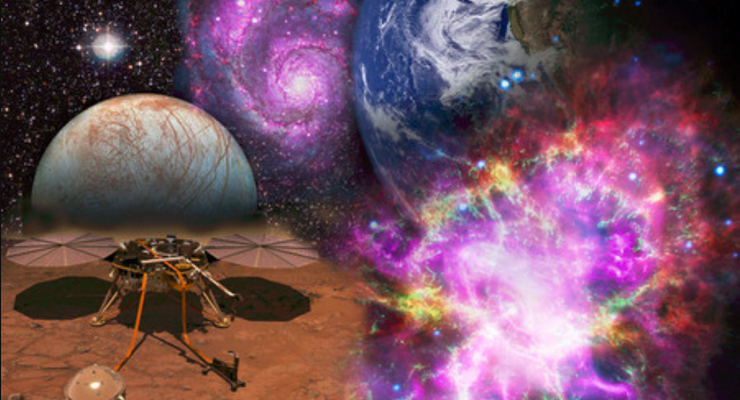Friday is the 49th anniversary of the day Neil Armstrong and his Apollo 11 crew landed and walked on the moon and forever changed the way mankind would look at the night sky.
Back on earth, in Pasadena, Friday is also the 60th anniversary of an astronomy organization comprised of some of the top minds in the field formed in 1958, in the wake of the launch of the U.S.’s first satellite, the JPL-built and operated Explorer 1.
The Committee on Space Research, or COSPAR, is back in Pasadena this week for a convention which is filling the Pasadena Convention Center and the Hilton Pasadena with about 2,500 international space experts excited about their latest findings. In just the last year, those breakthroughs read like a Hit Parade of astronomical revelations.
With these new discoveries expanding our understanding of the universe every day, as well as new commercially-driven space initiatives to build better, cheaper spacecraft, those who spend their nights gazing into the cosmos have a lot to spark their imaginations.
It’s this type of cutting-edge research about our solar system’s icy worlds, new space telescopes, climate science, exoplanets, the search of life beyond Earth and more being discussed at COSPAR.
At the same time, Pasadena is sponsoring a week of lectures, exhibits and activities for amateur space enthusiasts during AstroFest, which continues through Saturday.
The MOONS art exhibit is ongoing at the ArtCenter’s Williamson Gallery from 7 p.m. to 10 p.m. daily through Dec. 16.
A public lecture and stargazing event with Caltech astronomers is planned for 8 p.m. Friday, with an initial meetup at the Cahill, Hameetman Auditorium at Caltech.
And an exhibit of rare 19th Century astronomical prints titled “Radiant Beauty” will be on display from 10 a.m. to 5 p.m. Wednesday through Mondays at the West Hall of Huntington Library through July 30.
“We live in amazing time,” said David Ciardi, research astronomer and the chief scientist at the NASA Exoplanet Science Institute, at the Infrared Processing & Analysis Center, or IPAC, at Caltech.
“For thousands of years, humans have looked up at the night sky with wonder and awe, and we have asked ourselves very simple but very poignant questions, such as ‘What are those points of light in the night sky?’ ‘How does the Universe work?’ ‘Are we alone in the Universe?’ We now live in an era when we are actively answering these questions.”
Ciardi has been studying the stars for 25 years. He was involved in the first direct measurement of a non-spherical star, “caused by the star spinning so fast,” he explained.
But he’s devoted the last decade or so to the Kepler Space Telescope Mission, searching the blackness of space for undiscovered planets in alien solar systems, or “exoplanets.”
“I have been involved in the discovery and characterization of more than an 1,000 exoplanets,” he said.
He’s especially interested in studying planets in solar systems with more than one star at their center.
“Kepler has discovered thousands of planetary systems, and we know that for 15 to 20 percent of these systems, there is also a stellar companion,” Ciardi said. “We even know that sometimes the planets orbit around both stars: circumbinary planets. “I have been working to understand how commonly multi-star systems that host planets exist, and what influence those stars may have on the planetary content of those systems.”
Johanna Teske, a Hubble postdoctoral fellow at Carnegie Observatories in Pasadena, also studies exoplanets.
And she, too, looks to the sky for answers that affect us on Earth.
“ We work very empirically and based on facts and what can we know for sure, what can be observed. But I’m personally motivated by questions that, at least for a long time, seemed very philosophical, but now are are sort of within the reach of science: like, ‘Are we alone?’” Teske said. “So that certainly motivates me in my day-to-day research.”
And there are few better places for a stargazer to call home than Pasadena, she said.
“I didn’t really appreciate this before moving there, but now in my mind, Pasadena seems like one of the capitals in the world of astronomy,” according to Teske. “There were so many discoveries made in and around Pasadena by people whose work came through Pasadena.”
And the discoveries are far from over.
“But what’s also cool is there’s all this active research in astronomy happening in Pasadena, Teske said. “ Some of the leaders in the world in astronomy work in Pasadena, and you might see them at the grocery store and you might see them at the pool.”
It doesn’t take an advanced degree to appreciate astronomy.
“Astronomy inspires us as a people It helps us understand who we are and how we fit in the universe, and it helps us understand how precious and fragile our home is,” Ciardi said.
But it also benefits us right here on Earth.
“Astronomy helps us to understand our own world and the context in which we live, and helps us appreciate this great gift we have to support our life: the Earth orbiting the Sun,” Ciardi said. “If it was not for astronomy, we would not have understood the importance of greenhouse gases in helping to keep the Earth warm enough, or the dangers of too much greenhouse gas in the atmosphere.”

















